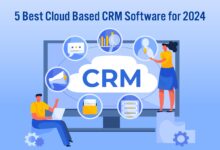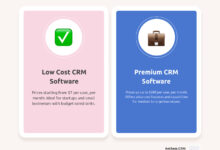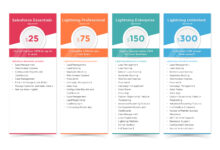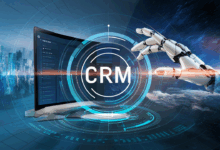Salesforce CRM Pricing: Unveiling Costs and Customization Options
Salesforce CRM pricing sets the stage for businesses to navigate the realm of customer relationship management with a focus on costs and customization. Dive into the intricacies of pricing tiers, hidden costs, negotiation strategies, and more to uncover the true value of Salesforce CRM.
Factors influencing Salesforce CRM pricing
When it comes to determining the pricing of Salesforce CRM, several key factors come into play that influence the overall cost for businesses.
Customization options play a significant role in affecting the pricing of Salesforce CRM. Businesses can choose to customize the CRM platform according to their specific needs and requirements, which can impact the final price based on the complexity of the customization.
Impact of Customization Options on Cost
Customization options in Salesforce CRM can range from simple configurations to more complex integrations with third-party applications. The more customization required, the higher the cost is likely to be due to additional development work and resources needed to tailor the CRM to the business’s unique processes.
- Basic configurations such as custom fields and workflows may incur minimal additional costs.
- Complex integrations with external systems or custom application development can significantly increase the overall price.
- Ongoing maintenance and support for customizations can also add to the total cost over time.
Pricing Models in the CRM Industry
In the CRM industry, various pricing models are used to determine the cost of CRM software. Some common pricing models include:
- Per User Pricing: Charging a set fee for each user accessing the CRM platform.
- Feature-based Pricing: Pricing based on the features and functionalities included in the CRM package.
- Usage-based Pricing: Charging based on the amount of data storage or API calls used by the business.
- Subscription Pricing: Offering CRM software through monthly or annual subscription plans.
Comparing Pricing Strategies
Salesforce employs a tiered pricing strategy, offering different editions of its CRM software with varying features and capabilities at different price points. This allows businesses to choose a package that aligns with their needs and budget.
Competitors in the CRM industry may follow similar pricing strategies but could differentiate themselves by offering unique features, integrations, or pricing models to attract customers. Understanding these differences can help businesses make informed decisions when selecting a CRM solution.
Salesforce CRM pricing tiers
When it comes to Salesforce CRM pricing, the platform offers different tiers to cater to the varying needs of businesses. Each tier comes with its own set of features, scalability options, customer support offerings, and additional integrations.
Tier 1: Essentials
- Basic features for small businesses
- Limited customization options
- Standard customer support
Tier 2: Professional
- More advanced features for growing businesses
- Increased customization capabilities
- Premium customer support
Tier 3: Enterprise
- Comprehensive features for large enterprises
- High-level customization and scalability
- Dedicated customer support
Tier 4: Unlimited
- Full suite of features for complex organizations
- Maximum customization and flexibility
- Priority customer support with dedicated account manager
| Tier | Features | Scalability | Customer Support |
|---|---|---|---|
| Essentials | Basic | Limited | Standard |
| Professional | Advanced | Medium | Premium |
| Enterprise | Comprehensive | High | Dedicated |
| Unlimited | Full suite | Maximum | Priority with account manager |
Hidden costs in Salesforce CRM pricing
When considering Salesforce CRM pricing, it’s important to be aware of potential hidden costs that may impact your overall budget. These additional expenses can arise beyond the base pricing and affect the customization and add-ons you choose.
Customization Expenses
Customizing Salesforce CRM to meet your specific business needs can incur additional costs. Whether it’s integrating third-party apps, creating custom workflows, or developing unique features, these customization expenses can add up quickly.
Impact of Add-Ons
Adding extra features or functionalities through Salesforce’s various add-ons can significantly impact your overall pricing. These add-ons may include advanced analytics, marketing automation tools, or additional storage capacity, each coming with its own price tag.
Budgeting Tips
- Start by clearly defining your requirements and objectives to avoid unnecessary add-ons or customization.
- Research and compare the costs of different add-ons and customization options to find the most cost-effective solutions.
- Consider the scalability of your CRM system and how future growth may impact your pricing in terms of add-ons and customization.
- Regularly review your Salesforce CRM usage to identify any unused features or unnecessary expenses that can be trimmed to optimize your budget.
Salesforce CRM pricing negotiation
Negotiating pricing with Salesforce can be a crucial step in getting the best deal for your business. Here are some strategies to help you navigate the negotiation process and secure a favorable pricing plan.
Understanding your needs
Before entering negotiations with Salesforce, it is essential to have a clear understanding of your organization’s specific CRM requirements. This includes the number of users, desired features, and any customization needs. By knowing exactly what you need, you can negotiate a pricing plan that aligns with your budget and goals.
Leveraging volume discounts
Salesforce often offers volume discounts for customers with a large number of users or multiple products. If your organization falls into this category, be sure to inquire about potential discounts based on your usage volume. By leveraging these discounts, you can lower your overall CRM costs significantly.
Timing is key
Timing can play a critical role in negotiating better pricing with Salesforce. Reach out to Salesforce towards the end of their fiscal quarter when sales teams are more likely to be motivated to close deals and may be willing to offer discounts to meet their targets. Additionally, consider negotiating during promotional periods or events when Salesforce may run special offers or discounts.
Understanding contract terms
During negotiations, it is crucial to pay close attention to the contract terms and conditions offered by Salesforce. Make sure to clarify any ambiguities, understand the pricing structure, renewal terms, and potential hidden costs. By having a clear grasp of the contract terms, you can avoid surprises and ensure that you are getting the most value for your investment.
Cost comparison with other CRM solutions
When comparing Salesforce CRM pricing with other CRM providers, it’s essential to consider the key features and pricing tiers offered by each platform. This comparison can help businesses make informed decisions based on their specific needs and budget constraints.
Value Proposition of Salesforce CRM
Salesforce CRM stands out from competitors due to its unique features such as robust customization options, advanced analytics capabilities, seamless integration with other business tools, and a user-friendly interface. These features contribute to improved efficiency, productivity, and customer satisfaction.
Scenarios where Salesforce pricing is justified
Large enterprises with complex CRM needs or businesses that require extensive customization can benefit greatly from Salesforce CRM. The platform’s scalability, flexibility, and support for various industries make it a suitable choice for organizations looking to streamline their operations and enhance customer relationships.
Factors to consider when choosing between Salesforce and other CRM solutions
When making a decision based on pricing, factors such as scalability, integration capabilities, and ongoing support costs should be taken into account. Salesforce offers a wide range of integrations and customization options, making it a versatile solution for businesses of all sizes. However, businesses should also consider the total cost of ownership over time to ensure they are getting the best value for their investment.
Pricing transparency in Salesforce CRM
When it comes to pricing transparency in Salesforce CRM, customers can expect a high level of clarity and openness in understanding the breakdown of costs and fees associated with the service.
Communication of Pricing Changes
Salesforce communicates pricing changes to customers through various channels such as email notifications, announcements on their website, and direct communication from their sales representatives. Updates on pricing changes are typically provided in a timely manner to ensure customers are well-informed.
Consistency in Pricing
Salesforce maintains pricing consistency across different customer segments and product offerings by adhering to standardized pricing models and clearly defining the pricing structures for each service or feature. This helps in ensuring fairness and transparency for all customers.
Customer Feedback on Pricing Transparency
Customer feedback on pricing transparency in Salesforce CRM has generally been positive, with users appreciating the clear pricing information provided by the company. Specific examples or case studies highlighting customer satisfaction with pricing transparency can further solidify this point.
Recommendations for Enhanced Transparency
To further enhance pricing transparency and improve customer understanding and satisfaction, Salesforce can consider providing more detailed breakdowns of costs, offering transparent pricing comparison tools, and actively seeking and implementing customer feedback on pricing structures.
Discounts and promotions in Salesforce pricing
When it comes to Salesforce pricing, discounts and promotions can play a significant role in maximizing savings and getting the best value for your investment. Let’s delve into the various aspects of discounts and promotions offered by Salesforce.
Common Discounts Offered by Salesforce
- Volume Discounts: Salesforce often provides discounts for organizations purchasing a large number of user licenses.
- Nonprofit Discounts: Nonprofit organizations may be eligible for special discounted pricing.
- Education Discounts: Educational institutions can benefit from discounted rates on Salesforce subscriptions.
Seasonal Promotions and Special Offers
- Salesforce occasionally runs seasonal promotions, such as discounts during holiday seasons or special events.
- Special offers may include discounted rates for new customers or additional features at no extra cost.
Tips to Maximize Savings through Discounts
- Stay informed about ongoing promotions and discounts by regularly checking Salesforce’s website or subscribing to their newsletter.
- Negotiate with Salesforce sales representatives to explore available discount options based on your organization’s needs.
- Consider bundling services or committing to long-term contracts to unlock additional savings.
Examples of Successful Negotiation for Discounts
- Case Study: Company X negotiated a 15% discount on their Salesforce subscription by committing to a 3-year contract.
- Case Study: Nonprofit Organization Y received a 20% discount on Salesforce licenses by leveraging their nonprofit status.
Leveraging Loyalty Programs for Additional Discounts
- Salesforce offers loyalty programs that reward existing customers with exclusive discounts or perks for renewing their subscriptions.
- Customers can accumulate loyalty points over time and redeem them for discounts on future purchases or upgrades.
Comparison Table of Discount Structures based on Subscription Plans
| Subscription Plan | Discount Offered |
|---|---|
| Basic | 10% off for annual subscription |
| Professional | 15% off for 2-year commitment |
| Enterprise | 20% off for nonprofit organizations |
Combining Multiple Discounts for Maximum Savings
- Customers can often combine volume discounts with seasonal promotions or loyalty program benefits to maximize savings.
- Work with Salesforce representatives to explore all available discount options and find the best combination for your organization.
Strategies for Renewing Contracts at a Discounted Rate
- Start the renewal process early and engage in negotiations to secure a discounted rate for your next subscription period.
- Highlight your organization’s loyalty and commitment to Salesforce to potentially unlock renewal discounts or special offers.
Customization impact on Salesforce CRM pricing
Customization plays a crucial role in determining the pricing of Salesforce CRM. By tailoring the platform to fit specific business needs, companies can enhance efficiency and productivity. However, customization also comes with its own set of costs that need to be carefully considered.
Examples of customized solutions and their associated costs
- Customized reporting dashboards: $5,000 one-time setup fee
- Integration with third-party applications: $1,500 per month
- Customized workflow automation: $3,000 initial setup + $500 monthly maintenance
Balance between customization and cost-effectiveness
Customization can be a powerful tool for maximizing the value of Salesforce CRM, but it’s essential to strike a balance between customization and cost-effectiveness. Companies should evaluate the ROI of each customization to ensure that it aligns with their budget and strategic objectives.
Insights on optimizing customization within budget constraints
- Identify critical business processes that require customization
- Prioritize customization projects based on their impact on business outcomes
- Work closely with Salesforce consultants to explore cost-effective customization options
- Regularly review and reassess the need for ongoing customizations
Step-by-step process for evaluating the cost-benefit analysis of customization in Salesforce CRM
- Define customization objectives and goals
- Estimate the costs associated with customization
- Calculate the potential benefits and ROI of customization
- Compare the costs and benefits to determine the viability of customization
Comparison chart illustrating the pricing differences between standard features and custom solutions in Salesforce CRM
| Feature | Standard Price | Customization Cost |
|---|---|---|
| Reporting Dashboard | $0 | $5,000 |
| Third-party Integration | $0 | $1,500 per month |
| Workflow Automation | $0 | $3,000 initial + $500 monthly |
Factors influencing the cost of customization
- Complexity of customization requirements
- Integration needs with other systems
- Data volume and migration complexity
Case study showcasing a successful customization project in Salesforce CRM
ABC Corp implemented a custom reporting dashboard in Salesforce CRM, leading to a 20% increase in sales productivity and a 15% reduction in response time to customer queries. The initial customization cost of $5,000 was quickly offset by the improved efficiency and revenue growth.
Pricing flexibility in Salesforce CRM
When it comes to Salesforce CRM, pricing flexibility is a key factor that allows businesses to customize their plans according to their specific needs and budget constraints. This flexibility enables businesses to optimize their CRM investment and maximize their ROI.
Tailoring pricing to specific needs
- Businesses can choose from a variety of pricing options, such as per user/per month, enterprise pricing, or customized plans based on specific requirements.
- By tailoring pricing to their specific needs, businesses can avoid paying for features they do not need, resulting in cost savings.
Examples of businesses benefiting from flexible pricing
- A small startup may opt for a basic plan with essential features to keep costs low initially.
- A large enterprise may choose an enterprise pricing plan with advanced functionalities to cater to their complex CRM needs.
Leveraging pricing flexibility for cost savings
- Businesses can periodically review their CRM usage and adjust their pricing plan accordingly to ensure they are not overpaying for unused features.
- Regularly communicating with Salesforce representatives to explore cost-saving opportunities and discounts can help businesses optimize their pricing.
Creating a customized pricing plan in Salesforce CRM
- Businesses can work with Salesforce account managers to create a customized pricing plan that aligns with their unique requirements and budget.
- Factors such as the number of users, required features, contract length, and add-on services can be considered when creating a customized pricing plan.
Comparison of different pricing models in Salesforce CRM
| Pricing Model | Features |
|---|---|
| Per User/Per Month | Basic features, suitable for small businesses |
| Enterprise Pricing | Advanced features, scalability for large enterprises |
| Customized Plans | Tailored features based on specific requirements |
Case study on dynamic pricing strategies in Salesforce CRM
A manufacturing company implemented dynamic pricing in Salesforce CRM, adjusting pricing based on customer segments and market demand. This resulted in a 15% increase in revenue within the first quarter of implementation.
Price-performance ratio in Salesforce CRM
When it comes to evaluating the price-performance ratio in Salesforce CRM, it is essential to analyze how the cost of the system aligns with its efficiency in delivering value to businesses. Let’s delve deeper into this aspect.
Efficiency of Salesforce CRM
- Salesforce CRM offers a wide range of features and functionalities that can streamline business processes, enhance customer relationships, and drive sales growth.
- The system’s user-friendly interface and customizable options make it easy for businesses to adapt the CRM to their specific needs and workflows.
- Integration with other tools and applications further enhances the overall efficiency and productivity of Salesforce CRM users.
Value Delivery
- Businesses that effectively leverage Salesforce CRM often see a significant return on investment (ROI) due to improved sales performance, customer satisfaction, and operational efficiency.
- By aligning pricing with the value delivered, Salesforce CRM ensures that organizations can maximize their benefits and achieve long-term success.
- Examples of companies achieving high ROI with Salesforce CRM include Coca-Cola, Toyota, and T-Mobile, who have reported increased sales, improved customer retention, and streamlined operations.
Tiered pricing advantages and disadvantages
Tiered pricing is a popular pricing model in Salesforce CRM that offers various advantages and disadvantages to businesses. This pricing structure involves different tiers or levels of pricing based on the features and functionalities included in each tier.
Advantages of Tiered Pricing
- Customization: Tiered pricing allows businesses to choose a pricing tier that aligns with their specific needs and budget, providing flexibility and customization options.
- Scalability: Businesses can easily scale up or down their CRM usage by moving between different tiers as their needs evolve, ensuring cost-effectiveness.
- Value-based pricing: Customers can select a tier that offers the most value for their investment, ensuring that they only pay for the features they require.
- Incentivizes upgrades: Tiered pricing encourages customers to upgrade to higher tiers to access more advanced features, leading to potential upselling opportunities.
Disadvantages of Tiered Pricing
- Complexity: Managing multiple tiers can be complex and challenging, especially for businesses with changing needs or limited resources.
- Costly for small businesses: Smaller businesses may find it difficult to afford higher-tiered pricing, limiting their access to advanced features and functionalities.
- Unpredictable costs: Fluctuations in usage and feature requirements can lead to unpredictable costs, making budgeting and forecasting more challenging.
- Customer confusion: With multiple pricing tiers, customers may find it confusing to choose the right tier that best suits their needs, potentially leading to decision paralysis.
Comparison with Other Pricing Structures
Tiered pricing is often compared with flat-rate pricing and usage-based pricing models. While tiered pricing offers customization and value-based options, flat-rate pricing provides simplicity and predictability, and usage-based pricing offers flexibility based on actual usage.
Businesses Benefiting from Tiered Pricing
One example of a business benefiting from tiered pricing is a software company that offers CRM solutions to different industries. By structuring their pricing into tiers, they can cater to the varying needs and budgets of their diverse customer base, maximizing revenue and customer satisfaction.
Upfront costs vs. long-term expenses in Salesforce CRM
When considering Salesforce CRM pricing, it is essential to look beyond just the upfront costs and take into account the long-term expenses associated with using the platform. Understanding the total cost of ownership over time can help businesses make informed decisions and effectively budget for CRM costs.
Comparing Upfront Costs with Long-Term Expenses
- Upfront Costs: The initial investment required to implement Salesforce CRM includes license fees, setup costs, training expenses, and customization fees.
- Long-Term Expenses: Over time, businesses need to consider recurring subscription fees, maintenance costs, upgrades, and additional user licenses as their organization grows.
- It is important to analyze how these upfront costs compare to the long-term expenses to evaluate the overall financial impact of choosing Salesforce CRM.
Mitigating Long-Term Expenses
- Regularly review and optimize your Salesforce CRM usage to ensure you are not paying for unused features or licenses.
- Invest in employee training to maximize user adoption and reduce the need for costly support services.
- Stay informed about upcoming Salesforce updates and new releases to plan for any necessary upgrades or changes in customization.
Strategies for Planning and Budgeting
- Create a detailed CRM budget that includes both upfront costs and estimated long-term expenses to avoid financial surprises.
- Utilize forecasting tools and analytics within Salesforce CRM to predict future costs based on usage patterns and growth projections.
- Engage with Salesforce experts or consultants to help develop a strategic roadmap for CRM implementation and ongoing cost management.
Pricing model evolution in Salesforce CRM
In the ever-evolving landscape of CRM solutions, Salesforce has undergone significant changes in its pricing models over the years. These modifications play a crucial role in shaping customer relationships and revenue generation for the company.
Evolution of Salesforce CRM Pricing Models
- Initial Stages: Salesforce started with a simple subscription-based pricing model, offering different tiers based on the level of features and functionalities.
- Market Dynamics Response: As competition intensified, Salesforce introduced more flexible pricing options such as per-user pricing, pay-as-you-go models, and enterprise-wide licenses to cater to diverse customer needs.
- Impact on Customer Satisfaction: The shift towards more customizable pricing models has improved customer retention rates by allowing businesses to tailor their CRM solutions according to their specific requirements.
- Revenue Generation Analysis: The effectiveness of these pricing modifications on revenue generation can be seen in Salesforce’s consistent growth and market dominance in the CRM industry.
Future Pricing Model Developments
- Emerging Technologies: With the rise of AI, automation, and analytics in CRM, Salesforce is likely to introduce pricing models that incorporate these advanced technologies to provide more value to customers.
- Customer Preferences: As customer expectations evolve, Salesforce may explore outcome-based pricing, usage-based pricing, or bundled pricing strategies to align with the changing needs of businesses.
- Predictions: It is anticipated that Salesforce will continue to innovate its pricing models to stay ahead of competitors and ensure long-term sustainability in the CRM market.
Salesforce CRM pricing for small vs. large enterprises
When it comes to Salesforce CRM pricing, the structure for small and large enterprises can vary significantly. Understanding these differences is crucial for businesses of all sizes to make informed decisions regarding their CRM investment.
Pricing Structures for Small and Large Enterprises
Small businesses often have limited budgets and specific needs compared to larger enterprises. Salesforce offers pricing plans tailored to each segment, with small businesses typically benefiting from more affordable options with essential features, while larger enterprises can access comprehensive packages with advanced functionalities and dedicated support.
- Small Enterprises: Small businesses can opt for entry-level pricing tiers that focus on core CRM features such as lead management, contact tracking, and basic reporting. These plans are designed to be cost-effective and user-friendly, making them ideal for businesses looking to establish a CRM system without extensive customization.
- Large Enterprises: On the other hand, larger enterprises have access to enterprise-level pricing tiers that include advanced features like AI-powered analytics, custom development options, and priority support. These plans are scalable and customizable to meet the complex needs of big organizations with multiple departments and high data volumes.
Scalability Options for Different Business Sizes
Salesforce CRM is known for its scalability, offering businesses the flexibility to adjust their CRM solutions as they grow. Small enterprises can start with basic features and gradually upgrade to more advanced functionalities as their operations expand. In contrast, large enterprises can leverage the platform’s robust capabilities to support intricate workflows and diverse user roles across the organization.
Examples of Pricing Plans for Diverse Business Needs
For instance, a small e-commerce startup may benefit from Salesforce’s Essentials plan, which provides essential sales and customer service tools at an affordable price point. On the other hand, a multinational corporation may require the Enterprise plan to integrate Salesforce CRM with their existing systems, automate complex processes, and analyze large datasets for strategic decision-making.
Optimizing Salesforce CRM Costs for Small Businesses
Small businesses can optimize their Salesforce CRM costs by prioritizing must-have features, setting a realistic budget, and exploring cost-effective customization options. By focusing on core functionalities that align with their business goals, small enterprises can maximize the value of their CRM investment without overspending.
| Pricing Tier | Included Features | Support Services |
|---|---|---|
| Small Enterprises | Lead Management, Contact Tracking, Basic Reporting | Email Support, Knowledge Base Access |
| Large Enterprises | AI-Powered Analytics, Custom Development, Priority Support | Dedicated Account Manager, 24/7 Phone Support |
Customer Testimonial: “As a small business owner, I found Salesforce’s pricing plans to be a perfect fit for my budget and needs. The scalability options allowed me to grow my CRM capabilities alongside my business expansion, ensuring a seamless transition without breaking the bank.”
Licensing and user-based pricing in Salesforce CRM
When it comes to Salesforce CRM pricing, understanding the licensing model and user-based pricing is crucial for businesses to make informed decisions on their CRM investment.
Licensing Model in Salesforce CRM Pricing
- Salesforce CRM uses a subscription-based licensing model where businesses pay a monthly or annual fee per user to access the CRM platform and its features.
- Users are categorized based on their roles and required functionality, with different pricing tiers available to accommodate varying user needs.
User-Based Pricing Impact on Overall Costs
- User-based pricing directly impacts the total cost of Salesforce CRM implementation, as businesses pay for each user accessing the platform.
- Scaling the number of users can significantly increase costs, making it essential for businesses to optimize user licenses based on actual usage and requirements.
Comparison with Other Licensing Models
- Compared to other licensing models like per-feature or per-module pricing, user-based pricing in Salesforce CRM provides more flexibility and scalability for businesses.
- While user-based pricing may seem costly upfront, it offers a transparent and predictable cost structure compared to variable pricing based on features or usage.
Optimizing User-Based Pricing for Cost-Efficiency
- Businesses can optimize user-based pricing in Salesforce CRM by conducting regular audits to identify unused or underutilized licenses and reallocate them accordingly.
- Implementing role-based access controls and defining user profiles can help businesses align license types with actual user needs, reducing unnecessary costs.
- Utilizing reporting and analytics features within Salesforce CRM can provide insights into user engagement and productivity, enabling businesses to make informed decisions on license optimization.
Closing Summary
In conclusion, Salesforce CRM pricing unveils a world of possibilities for businesses seeking to optimize their customer relationships. By understanding the nuances of costs, customization, and pricing models, companies can leverage Salesforce CRM to its fullest potential and drive growth in today’s competitive landscape.




